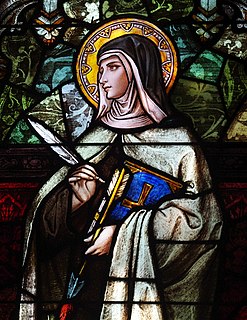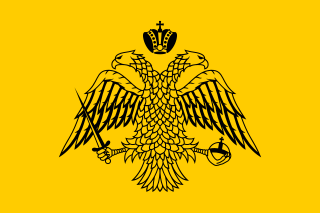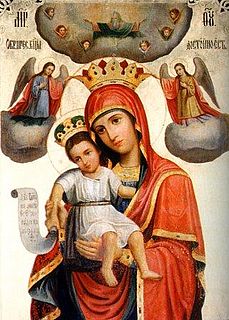
Great Lent, or the Great Fast, is the most important fasting season in the church year in the Byzantine Rite of the Eastern Orthodox Church, Byzantine Rite Lutheran Churches and the Eastern Catholic Churches, which prepares Christians for the greatest feast of the church year, Pascha (Easter).
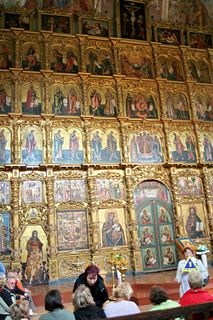
The Byzantine Rite, also known as the Greek Rite or Constantinopolitan Rite, is the liturgical rite used by the Eastern Orthodox Church, the Greek/Byzantine Catholic churches, and in a modified form, Byzantine Rite Lutheranism. Its development began during the fourth century in Constantinople and it is now the second most-used ecclesiastical rite in Christendom after the Roman Rite.

The Liturgy of Saint James or Jacobite Liturgy is the oldest complete form of the Eastern varieties of the Christian liturgy still in use among certain Christian Churches.
In the Byzantine Rite of the Eastern Orthodox Church and the Eastern Catholic Churches, Orthros (Greek or Oútrenya is the last of the four night offices, which also include vespers, compline, and midnight office. In traditional monasteries it is held daily so as to end at sunrise. In many parishes it is held only on Sundays and feast days. It is often called matins after the office it most nearly corresponds to in Western Christian churches.

The Apolytikion or Dismissal Hymn is a troparion (hymn) said or sung at Orthodox Christian worship services. The apolytikion summarizes the feast being celebrated that day. It is chanted at Vespers, Matins and the Divine Liturgy; and it is read at each of the Little Hours. The name derives from the fact that it is chanted for the first time before the dismissal of Vespers. In the Orthodox Church, the liturgical day begins at sunset, so Vespers is the first service of the day. The term apolytikion is used in Greek tradition. In Slavic tradition the term troparion is specifically used to stand for Apolytikion, whilst troparion is of more generic usage in Greek tradition.

In Eastern Orthodox and Byzantine Catholic churches, an entrance is a procession during which the clergy enter into the sanctuary through the Holy Doors. The origin of these entrances goes back to the early church, when the liturgical books and sacred vessels were kept in special storage rooms for safe keeping and the procession was necessary to bring these objects into the church when needed. Over the centuries, these processions have grown more elaborate, and nowadays are accompanied by incense, candles and liturgical fans. In the liturgical theology of the Orthodox Church, the angels are believed to enter with the clergy into the sanctuary, as evidenced by the prayers which accompany the various entrances.

A troparion in Byzantine music and in the religious music of Eastern Orthodox Christianity is a short hymn of one stanza, or organised in more complex forms as series of stanzas.
Acolouthia in the Eastern Orthodox and Eastern Catholic churches, signifies the arrangement of the Divine Services, perhaps because the parts are closely connected and follow in order. In a more restricted sense, the term "acolouth" refers to the fixed portion of the Office. The portions of the Office that are variable are called the Sequences. While the structure and history of the various forms of the Divine Office in the numerous ancient Christian rites is exceedingly rich, the following article will restrict itself to the practice as it evolved in the Eastern Roman (Byzantine) Empire.

The Paschal troparion or Christos anesti is the characteristic hymn for the celebration of the Orthodox Pascha (Easter) in the Eastern Orthodox Church and churches that follow the Byzantine Rite.

Eastern Orthodox worship in this article is distinguished from Eastern Orthodox prayer in that 'worship' refers to the activity of the Christian Church as a body offering up prayers to God while 'prayer' refers to the individual devotional traditions of the Orthodox.
The liturgical book called Octoechos contains a repertoire of hymns ordered in eight parts according to the eight echoi. Originally created as a hymn book with musical notation in the Stoudios monastery during the 9th century, it is still used in many rites of Eastern Christianity. The hymn book has something in common with the book tonary of the Western Church. Both contained the melodic models of the octoechos system, but the tonary served simply for a modal classification, while the book octoechos is as well organized as a certain temporal of several eight week periods and the word itself means the repertoire of hymns sung during the celebrations of the Sunday Office.

Lazarus Saturday in the Eastern Orthodox Church and Oriental Orthodoxy is the day before Palm Sunday to which it is liturgically linked. It celebrates the raising of Lazarus of Bethany, the narrative of which is found in the Gospel of John.
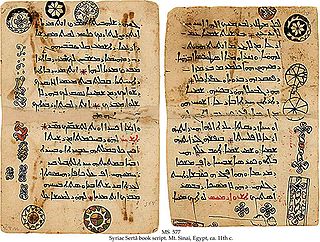
Irmologion is a liturgical book of the Eastern Orthodox Church and those Eastern Catholic Churches which follow the Byzantine Rite. It contains irmoi organised in sequences of odes and such a sequence was called canon. These canons of nine, eight, four or three odes are supposed to be chanted during the morning service (Orthros). The book Irmologion derives from heirmos which means "link". The irmos is a melodic model which preceded the composition of the odes. According to the etymology, the book "collects" the irmoi.
A Doxastikon —plural: doxastika— is a type of hymn found in the Divine Services of the Eastern Orthodox Church and those Eastern Catholic Churches which follow the Byzantine Rite.

A liturgical book, or service book, is a book published by the authority of a church body that contains the text and directions for the liturgy of its official religious services.
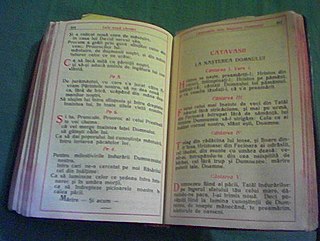
Katabasia or Katavasia is a type of hymn, and the last troparion of an ode of a canon, chanted in the Eastern Orthodox Church and those Eastern Catholic Churches which follow the Byzantine Rite. Its name is derived from the Greek word katabasia for descent, so called because the cantors used to go down from their stalls and unite in the middle of the church to sing them.




